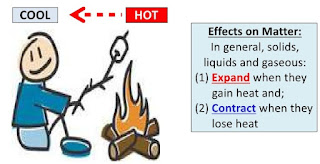Lesson Plan of Effects of Heat on Solids, Liquids and Gases General Science Grade IV
Lesson Plan of Effects of Heat on Solids, Liquids and Gases
General Science Grade IV
Students’ Learning Outcomes
·
Demonstrate and explain how
matter changes its state on heating.
Information for Teachers
·
One state of matter can be
changed into another by heating.
·
Solid ice changes into liquid
water with heat or keeping it at room temperature for some time.
·
Similarity liquid water
changes into steam (gas) on heating.
Material / Resources
Ice, water, glass, candle, match box, stainless
steel glass, handkerchiefs, textbook
Worm up Activity
·
Take a handkerchief and soak
it in water.
·
Ask students to touch it.
·
Spread it out in the open air
for half an hour.
·
Show it to the students and
ask them to touch it again.
·
Ask students what happened to
the handkerchief?
·
Where did the water go?
(Expected response: Water
escape in air in the form of vapors)
·
How did the liquid water
disappear or change into vapors?
(Students’ response: water
absorbed heat from surroundings and changed into vapors)
Development
Activity 1
·
Place some pieces of ice in a
glass.
·
Ask the students to observe
what will happen to the ice and why.
·
Students observe and then
answer the following questions:
·
What happened to the ice? (it
melted)
·
How did it change into liquid
water? (by heating)
·
Inform them that upon
heating, a solid changes into liquid. Ask them:
·
Why does water trickle down
from a vehicle carrying ice?
·
Why does a burning candle
melt?
Activity 2
·
Take 10-15ml water in a
stainless steel glass/beaker or any container.
·
Heat it with the help of a
candle or a spirit lamp.
·
What has happened to liquid
water?
(Students’ response: Heat has
changed water to steam or water vapors)
·
Which state of matter is
steam? (Steam is gas)
·
Conclude that upon heating a
liquid turns into gas vapors.
·
Ask what will happen if we
keep heating water?
(Expected response: water
will turn into steam)
·
Why does sweat dry while
sitting under a fan?
(Expected response: Sweat
will change into vapors)
Sum up / Conclusion
·
Conclude the topic by telling
that: One state of matter can be converted into another state either by heating
or cooling.
·
Liquid water can be changed
to steam or vapors by heating.
·
Water vapors present in air
can be changed to liquid water by cooling.
Assessment
·
Ask students: Write their
observations from everyday life where water is changed into steam and into ice.
·
When ice is placed in an open
container it melts into liquid water after sometimes. From where does it get
heat?
Follow up
·
Instruct them to:
v Take a small quantity of water in a plate.
v Put that plate under the sun.
v Observe what happens to the water after a few
hours.
(Students’ response: the whole water has
disappeared and the plate has dried up)
·
Ask the students to note down
their observation and discuss with their class fellows next day.






Comments
Post a Comment